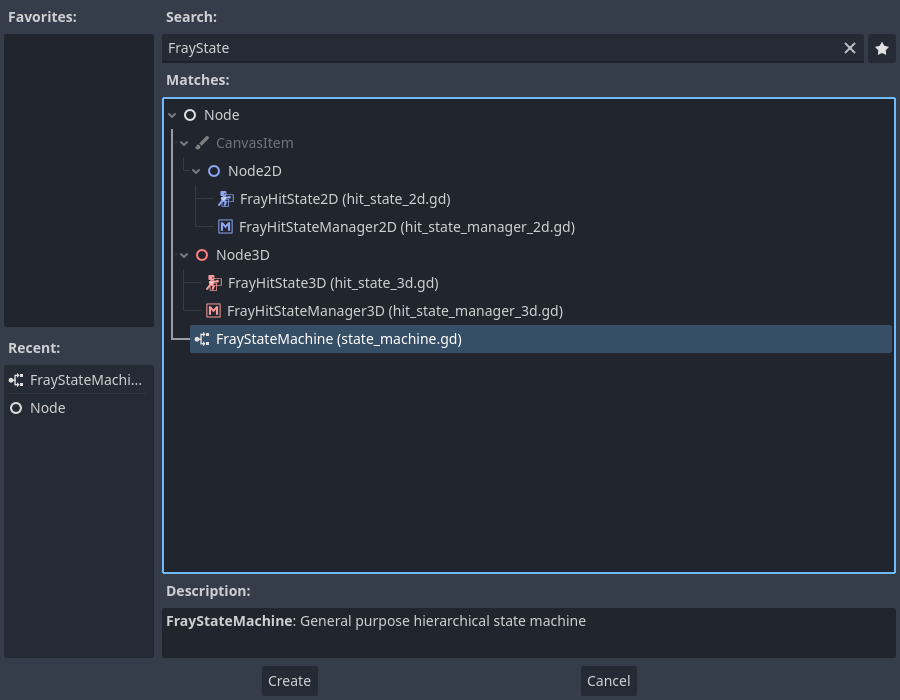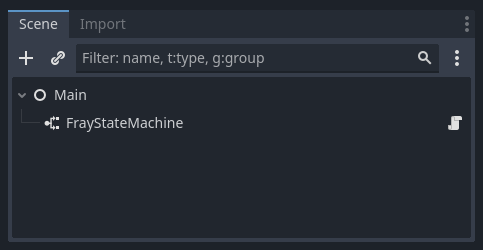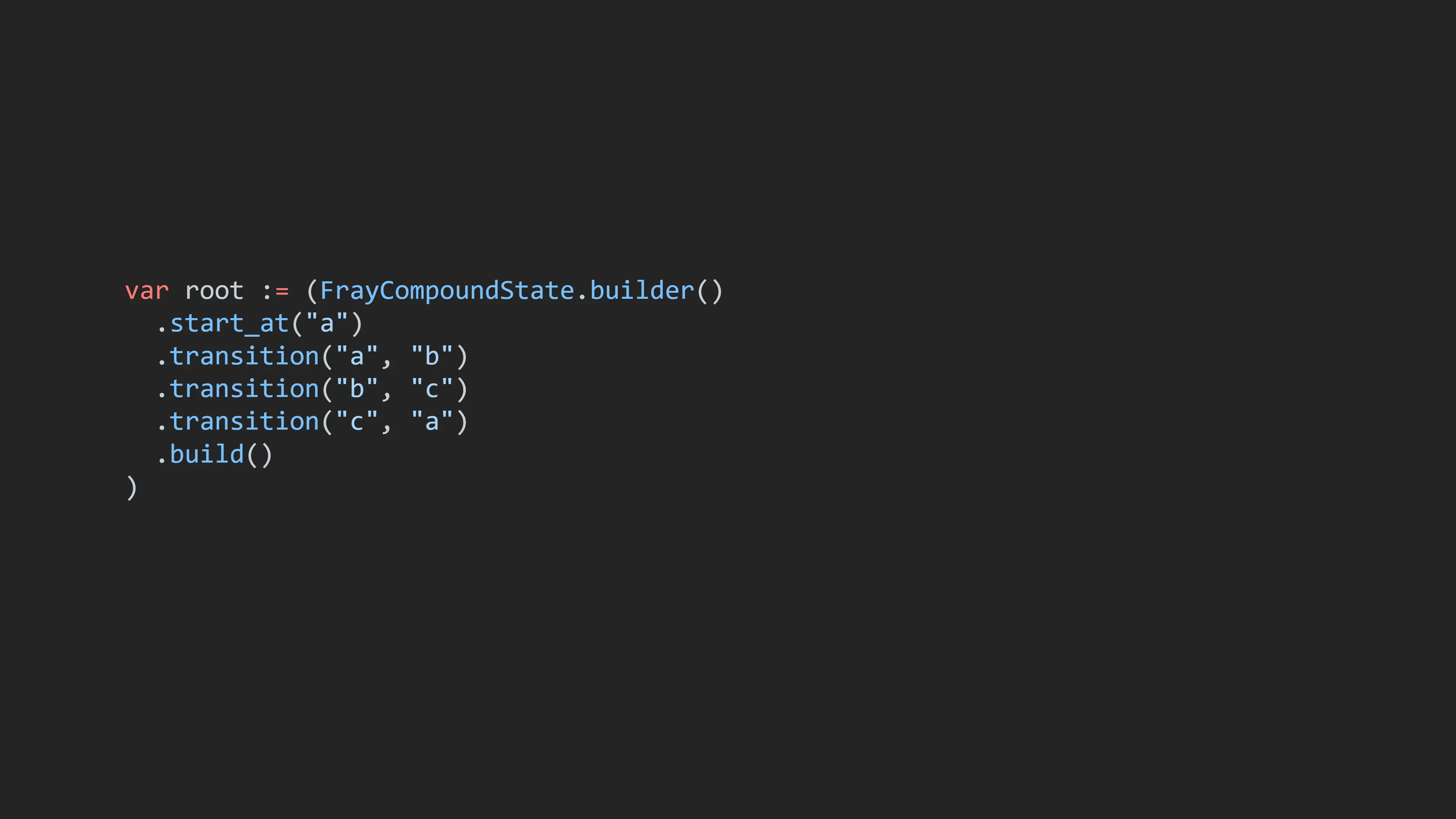Building A State Machine
What is a Hierarchical State Machine?
A state machine is a model that represents an entity's various states and the transitions between them in a finite and structured way. They can be visualized as a graph where each point is a state and the connecting lines are transitions. To be hierarchical means that within each state there can exist entire state machines, which is useful when modeling more complex behaviors.
1. Add State Machine To Scene
Before you can begin building a state machine first add a FrayStateMachine node to the scene. For this guide the node will be named 'FrayStateMachine'.


2. Build State Machine Root
All state machines require a FrayCompoundState root in order to function. Compound states are responsible for describing the set of states and transitions present within the state machine.
The compound state can be configured directly through methods such as add_state() and add_transition(). However, it is recommended to construct states using the included FrayCompoundState.Builderclass. An instance of the class can be obtained through the static FrayCompoundState.builder() method.
# Explicit Configuration
var root := FrayCompoundState.new()
root.add_state("a", FrayState.new())
root.add_state("b", FrayState.new())
root.add_state("c", FrayState.new())
root.add_transition("a", "b", FrayTransition.new())
root.add_transition("b", "c", FrayTransition.new())
root.add_transition("c", "a", FrayTransition.new())
root.start_state = "a"
# Builder Configuration
var root := (FrayCompoundState.builder()
.start_at("a")
.transition("a", "b")
.transition("b", "c")
.transition("c", "a")
.build()
)
With the exception of build(), all builder methods return an instance of the builder, allowing for chain method calls. Additionally, the builder will create a state instance whenever a state is mentioned, meaning it is not required to add a state before using it. However, the builder's add_state() method is required when adding custom states.
3. Initialize State Machine
Before a state machine can be used it needs to be initialized. The initialize() method takes 2 arguments. First a context, which is a dictionary that can be used to provide read-only data to custom states added to the system. Second, a FrayCompoundState, which serves as the root of the state machine.
state_machine.initialize({}, FrayCompoundState.builder()
.transition("a", "b", {auto_advance=true})
.transition("b", "c", {auto_advance=true})
.transition("c", "a", {auto_advance=true})
.build()
)Notice transition() takes an optional 3rd argument which is a dictionary that allows properties belonging to FrayStateMachineTransition. For this example auto advance is enabled as a simple way to see the state machine in action.
4. Observing State Transitions
Now that the state machine has been initialized state transitions can be observed using the state_changed signal on the state machine.
func _ready() -> void:
state_machine.state_changed.connect(_on_StateMachine_state_changed)
func _on_StateMachine_state_changed(from: StringName, to: StringName) -> void:
print("State transitioned from '%s' to '%s'" % [from, to])Before you can see the newly created state machine in action first select the state machine node in the tree and then from the inspector set the active property to true. Additionally, set advance_mode to manual. At the moment the state machine has nothing to limit its transitions so allowing it to advance automatically will result in the state machine cycling to the next avaialble state every frame.

Lastly since the state machine is set to manual mode, call the state machine's advance method inside of the _process() whenever ui_select is just pressed.
func _process(delta: float):
if Input.is_action_just_pressed("ui_select"):
state_machine.advance()Now whenever space is pressed the state will change and print a message informing that the current state has changed.
Alternatively the print_adj() method can be used to quickly print the state of a state machine for debug purposes.
func _process():
if Input.is_action_just_pressed("ui_select"):
state_machine.advance()
state_machine.get_root().print_adj()Conclusion
You should now have a script resembling the one below. This script assumes that the state machine is a direct child of the attached node.
extends Node
@onready var state_machine: FrayStateMachine = $FrayStateMachine
func _ready() -> void:
state_machine.state_changed.connect(_on_StateMachine_state_changed)
state_machine.initialize({}, FrayCompoundState.builder()
.transition("a", "b", {auto_advance=true})
.transition("b", "c", {auto_advance=true})
.transition("c", "a", {auto_advance=true})
.build()
)
func _process(delta: float):
if Input.is_action_just_pressed("ui_select"):
state_machine.advance()
func _on_StateMachine_state_changed(from: StringName, to: StringName) -> void:
print("State transitioned from '%s' to '%s'" % [from, to])